Bed bugs can be an absolute nightmare.
They’re expensive to deal with and cause physical and emotional injury.
To top it all off they’re notoriously hard to get rid of.
So the first step to controlling the situation…
Is to identify these creatures properly.
This is because there are over 11 common insects that look like bed bugs.
Therefore, accurate diagnosis is crucial so that you avoid costly treatment for the wrong type of bug.
Their overall look and shape will vary depending on:
- The age of the bed bug
- The species of bed bug
- Whether the bed bug has fed recently
- The severity of the infestation
- The surface they are standing on
So, let’s dive into what bed bugs look like in a variety of common situations.
Page Contents:
What Do Bed Bugs Look Like?
In general adult bed bugs are ¼ inch in length or about the size of a small seed. They’re typically flat with an oval-shaped body that allows them to fit into small spaces. If they have fed recently bed bugs will appear more balloon-like with a red tint.
Note: Bed bugs can travel fast, though you’ll notice that a bed bug that has recently been fed will be crawling much slower than its peers.
Bed bugs have the same characteristics of what’s called a “true bug.”
These include:
- Soft flat bodies
- Well-developed antennae
- Stink glands
Not only can you see bed bugs, but in severe cases you can smell them too.
This is a clue to an infestation, as bed bugs will release an odor when they get disturbed.
(This unique smell is due to alarm pheromones).
This is similar to the odor that stink bugs give off, and at high concentrations, it is quite unpleasant.
How unpleasant you ask?
In low concentrations people say it smells like coriander, but in high concentrations it’s more a mix of coriander and a pair of moldy sneakers.
Most “true bugs” also have a front pair of wings that are partially hardened.
This is a common misconception for bed bugs, as they do not have wings and cannot fly or jump.
Bed Bug Pictures
The below photo shows a few bed bugs that have recently been killed due to a diatomaceous earth treatment.
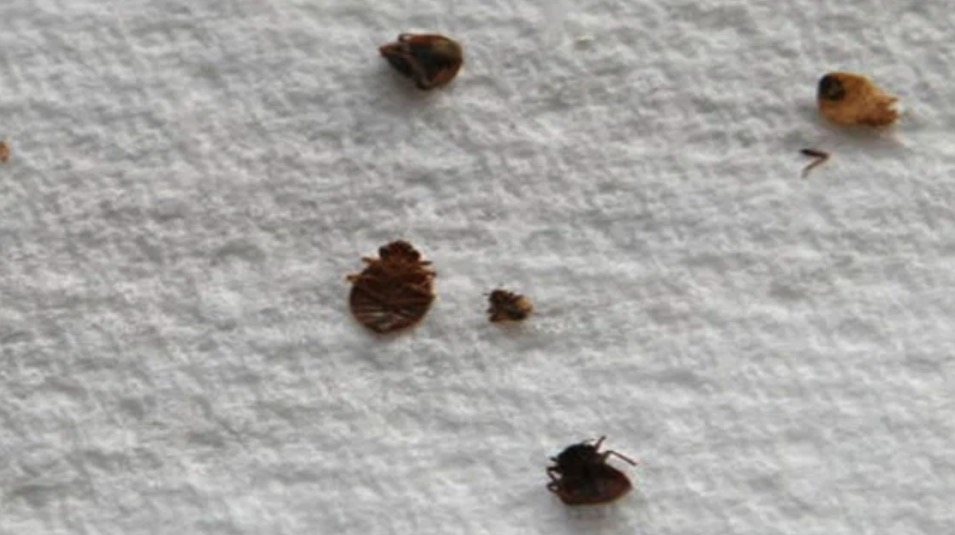
The photo below is a breakdown of bed bugs at different stages of their life cycle. On the left you will see bed bug eggs all the way to fully mature adult bed bugs on the right.

Below you will see an example of a bed bug nest. This is a cluster of bed bugs in a variety of life stages.
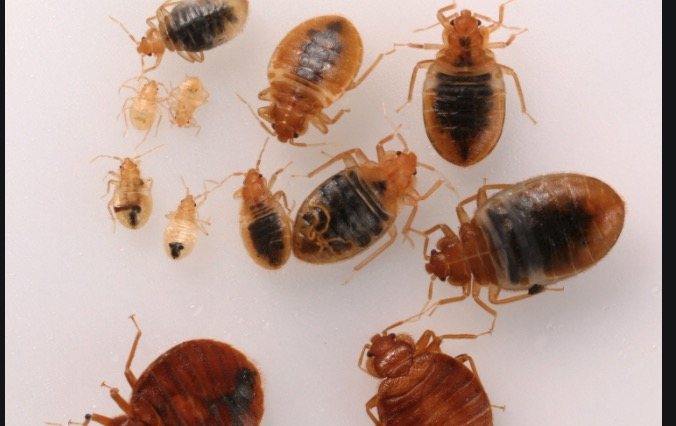
For a more comprehensive list of photos be sure to check out our bed bug gallery.
What Color Are Bed Bugs
The color of a bed bug will most often depend on what stage the bed bug is within its life cycle.
Adult Bed Bugs:
Fully mature bed bugs will have a darker, or rusty brown color. Depending on the bug this can range from light brown, to even black.
Baby Bed Bugs:
Bed bugs who have recently hatched…
(referred to as Nymphs).
Will be more translucent in color. This makes them much more difficult to see with the human eye.
Not only are baby bed bugs much smaller at around 2mm long, but their color can easily blend with a light surface, as sometimes baby bed bugs can be a light cream color or even a white-ish yellow in some cases.
Bed Bug Eggs:
Eggs can be difficult to see on their own, but because they’re usually in clusters they can be more easily identified.
Bed bug eggs are usually pearl white and very tiny.
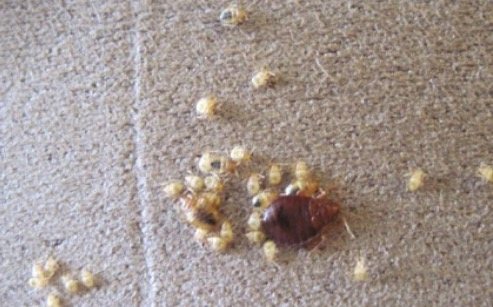
(About the size of a pinhead).
People say they’re able to spot bed bug eggs with the naked eye if they’re at least 5 days old, otherwise it may require a microscope.
What Do Bed Bugs Look Like on a Mattress?
Detecting bed bugs is no easy task, but the mattress is the first place you should look if you suspect an infestation. Though active bed bugs may only be visible at night, you can still find evidence of these creatures on your mattress during the daytime.
Bed bugs prefer to reside near their hosts, so they will typically hide within the folds of your mattress or cracks within the bed frame.
(Luckily there are special bed bug mattress covers that can fix that problem).
Evidence of bed bugs will most commonly show up in clusters in areas around your mattress that are not easily visible.

Bed bug evidence includes:
Black or brown spots. Which indicate bed bug droppings.
Red spots. This indicates a bloodstain that a bed bug left behind from a feeding.
Small oval-shaped translucent dots. An indication of bed bug eggs.
When inspecting your mattress…
You should use a flashlight AND blue latex gloves.
(as depicted in the image below).
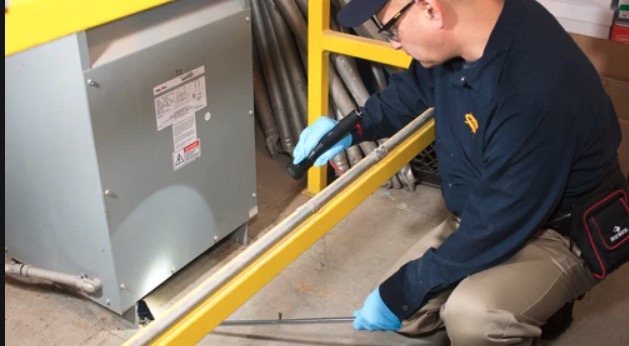
The color contrast of the gloves allows you to see bed bugs near your hands.
Peel away your bedding for a thorough inspection, and also check hidden areas within 6 to 8 feet of your bed.
These areas can be:
- Between the box spring and bed frame.
- Under the bed frame.
- Under or around your nightstand or dresser.
- On walls or baseboards.
- Behind wall hangings.
- Within or behind outlets.
- On floor or door molding where the carpet edges meet the wall.
What Do Bed Bugs Look Like Up Close?
The look of a bed bug can be deceiving, so if you get an up-close view, it can help you better determine whether the insect is in fact a bed bug. Bed bugs are rusty brown, wingless, and shaped similarly to a lentil.
To help confirm what you’re looking at it helps to dive further into this insect’s anatomy.
Since these creatures are quite allusive with their ability to hide…
You will likely need to capture a bed bug to get a better look.
Bed Bug Anatomy
Here is a quick anatomy breakdown of the common bed bug (Cimex Lectularius).

- Antennae:
Bed bugs use the antennae as sensors to guide them toward sleeping humans. Each antenna has 4 segments, that are about 1/8-inch-long
(Half as long as their entire bodies).
2. Proboscis:
The Proboscis is the mouth-like tube bed bugs use to draw blood from humans. As bed bugs feed, the proboscis injects anti-coagulating properties, so the blood doesn’t clot.
Each bite from a bed bug draws bout .0055mm of blood.
3. Eyes:
Bed bug eyes are comprised of many repeating segments that are ultra-sensitive to movement. This is the bed bug’s greatest asset.
The eyes allow them to avoid danger and stay hidden when not feeding.
4. Head:
Bed bug heads are short and wide. The heads attach directly to the bed bug thorax.
5. Thorax:
The thorax is the part of the insect where the legs attach to the body. This segment connects the head and allows bed bugs to crawl.
6. Wing Pads:
This part of the body indicates where wings would develop. While bed bugs have wing pads they do not ever fully develop wings and the ability to fly.
7. Legs:
Bed bugs have evolved to be travelers that can cover a few feet per minute.
Note: These creatures lack suction pads on their legs making it difficult for bed bugs to crawl up smooth surfaces. This is why you should set bed bug traps around the legs of your bed frame.
8. Abdomen:
There are 11 segments to the abdomen that expand as bed bugs feed. After a full feeding the abdomen appears swollen and red in color.
What Do Bed Bug Nests Look Like?
Technically, bed bugs don’t make nests. There are no built structures that can easily be seen like with ants or bees. Instead, bed bug nests are referred to as the areas when bed bugs congregate together and breed.
While an anthill or a beehive can be somewhat straightforward to remove…
Bed bug nests are more complicated.
These nets are often found in hidden, hard-to-reach places. Therefore, you will need to do a thorough search with a flashlight in order to locate the nest.
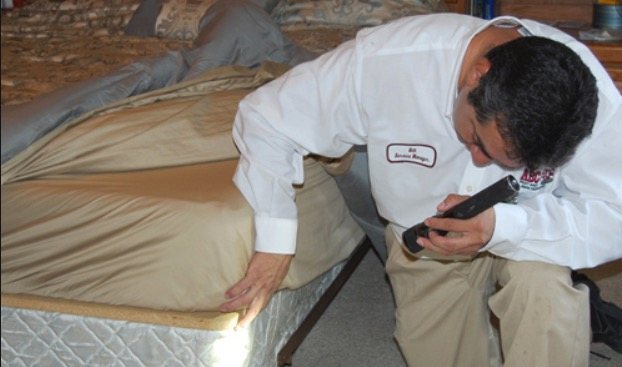
So where should you look for a nest?
The first room to search is the location in which you suspect bed bug activity. Since bed bugs don’t travel very far on their own, you can assume a nest is close to any tell-tale signs of bed bugs.
(Whether it be excrement, blood spots, or shed skins).
Unless you have an ultra-severe infestation on your hands…
There are places in your house that are typically bed bug free.
These are rooms like:
- Kitchens
- Bathrooms
- Hallways
- Or any other room that is rarely visited.
In fact, up to 90% of bed bug nests are found in the bedroom.
At the end of the day finding the nest is critical to a successful treatment. That’s why in some cases dogs are on the front line for detecting nests.
Remember: Even if one female bed bug is left behind, the entire infestation can come back in a matter of 30 to 60 days.

What Do Dead Bed Bugs Look Like?
The appearance of a dead bed bug can vary based on the type of treatment that was used. In general, when a bed bug dies they begin to dry out. This gives them a look of being shriveled or curled up due to final muscle contractions.
If you see a bed bug on its back, you can also assume that it’s dead.
Sometimes you can tell bed bugs are dead based on movement. Any live bed bug that’s been disturbed, will scurry away quickly. Therefore, if you get close to a bed bug and it doesn’t move… It’s likely dead.
This is not the case with undisturbed bed bugs that are hiding. Oftentimes in between meals, bed bugs will lay still for hours.
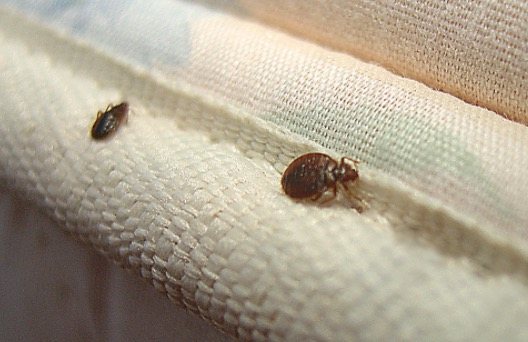
We should also note that bed bugs DO NOT play dead.
If they’re laying still it’s for a reason, but they never evolved the ability to play dead as a defense mechanism.
Certain insects do play dead for safety.
Some examples are:
- Caterpillars
- Weevils
- Robber Flies
- Water Bugs
- Lady Bugs
If you have recently undergone bed bug treatment, whether it be through a heat treatment or insecticides…

You’re likely to see a lot of dried out shriveled bed bugs lying around.
What Do Bed Bugs Look Like on Your Skin?
You typically won’t see live bed bugs on your skin since they only feed on you during the nighttime. The feeding process takes about 10 minutes, and then bed bugs will leave your skin to go back into hiding.
This is one of the reasons bed bugs are so dangerous.
Victims don’t even notice they’re being bitten until the morning after.
(When the bed bug is back in hiding).
Though you typically won’t see a live bed bug on your skin….
You will only notice the unsightly bites that they leave behind.
So, what do bed bug bites look like?
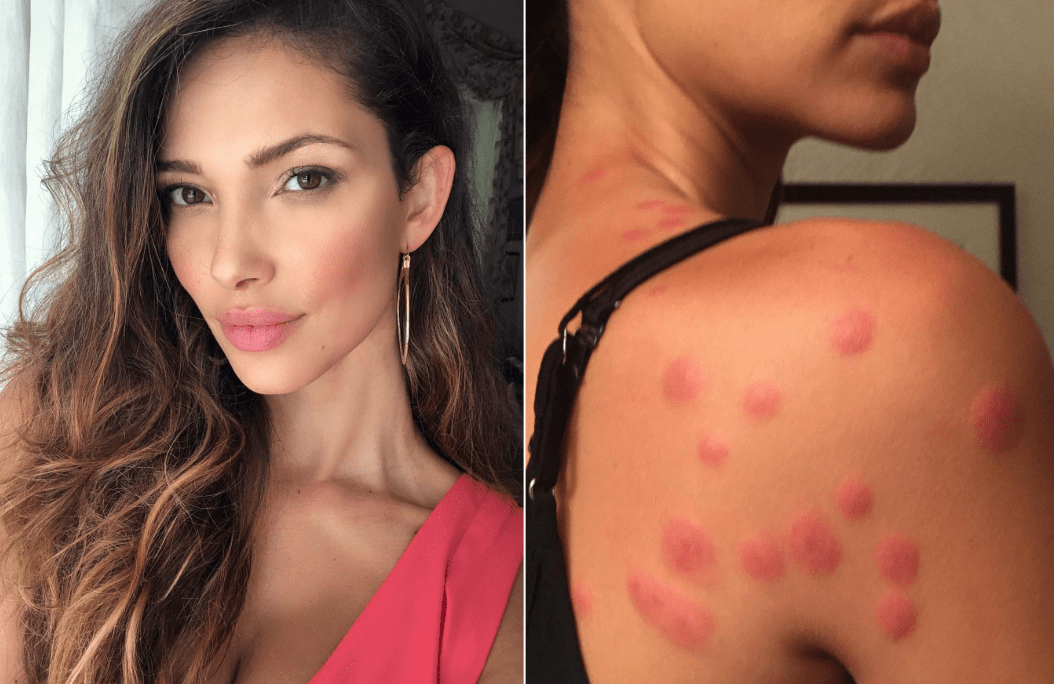
Bed bug bites have the following characteristics.
- They show up in the form of bumps or red welts.
- Bites are usually in a line or a zig-zag shape.
- They can be about the size of a dime (though this depends on the person).
There are cases where bites don’t show up for days after you’re bitten, and in rare cases, your skin may not even react to bites at all.
On the other side of it…
Some people can have severe symptoms to bites. This could lead to an allergic reaction, hives, trouble breathing, or severe irritation.

You Could be Eligible for Financial Compensation
If you or a loved one experienced financial loss or physical injury due to bed bugs in an apartment, hotel, or another location…
You may have a case to file a lawsuit.
The property owner could be held liable for knowingly placing you in a bed bug infested dwelling and could be responsible for any damages that ensue.
Get in touch with a bed bug personal injury lawyer by calling (855) 733-9217 or by submitting your case here for a free consultation.
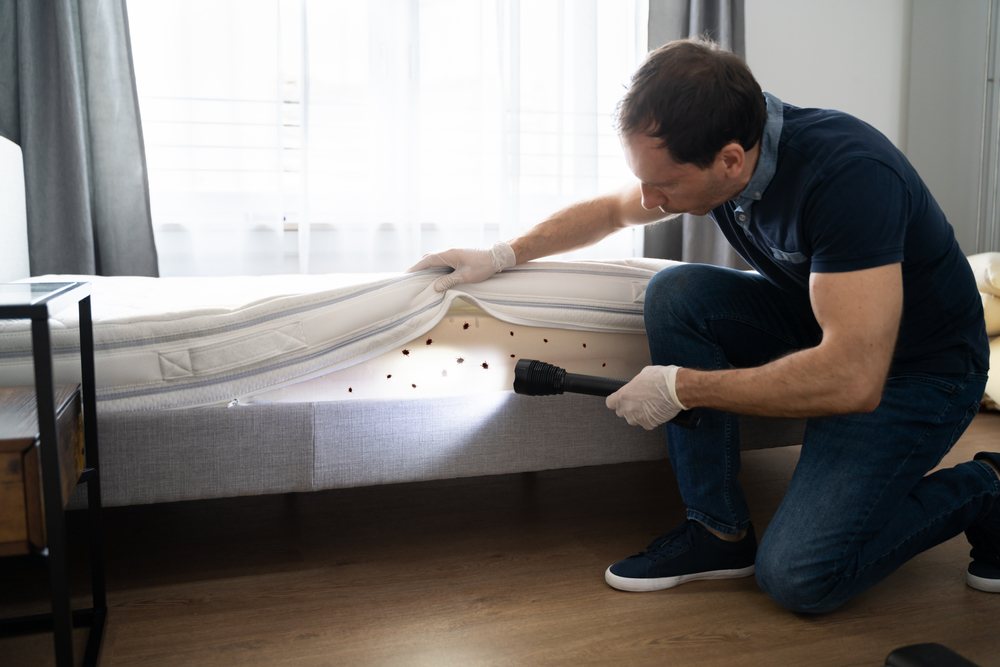


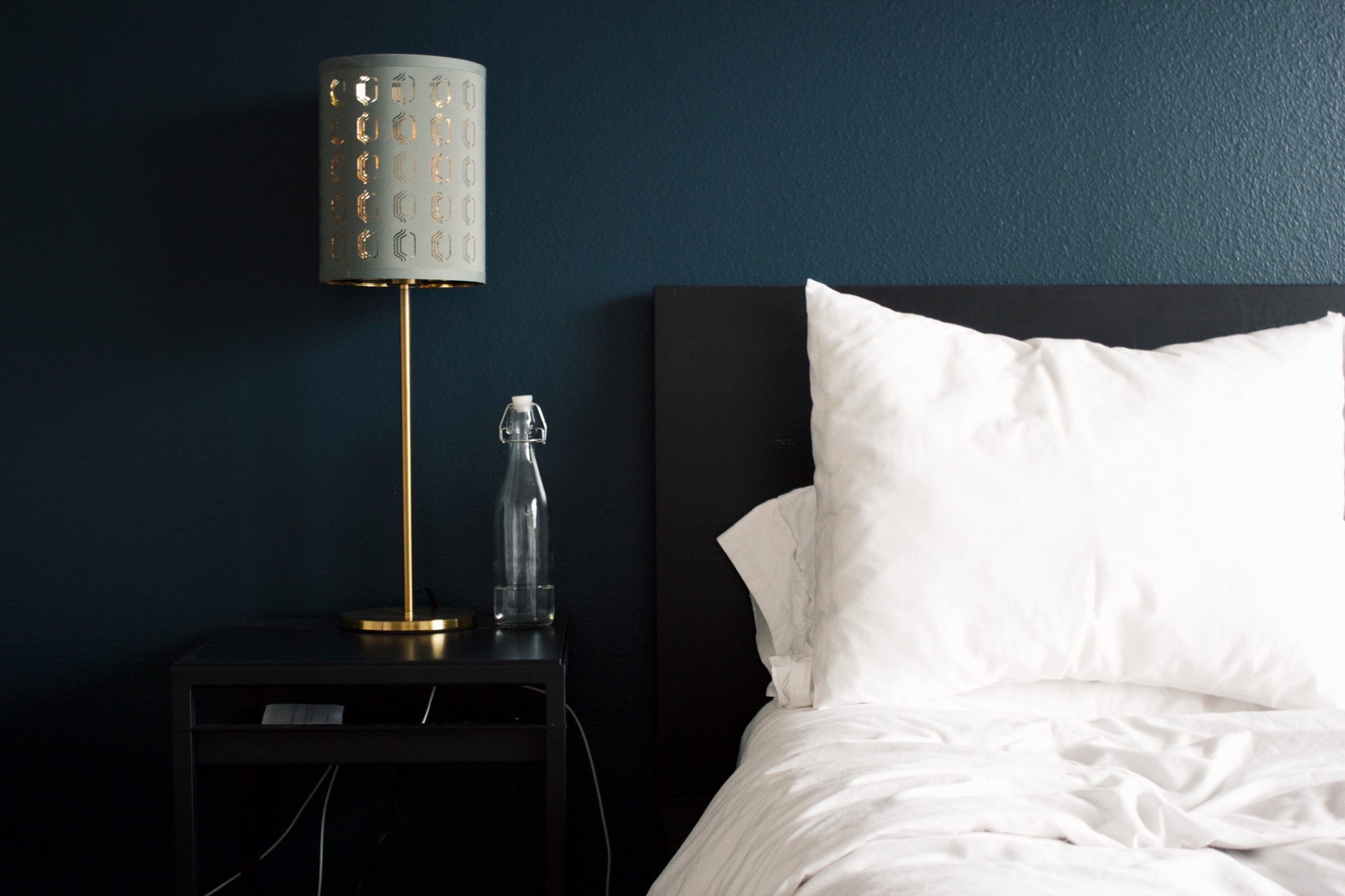


This is helpful. Thanks…. I have trouble identifying bed bugs because they are so small and I don’t have good eyes!!! I try to use a magnify glass but these things run quite fast. It’s very frustrating!